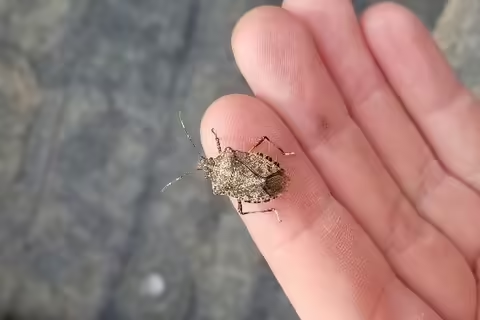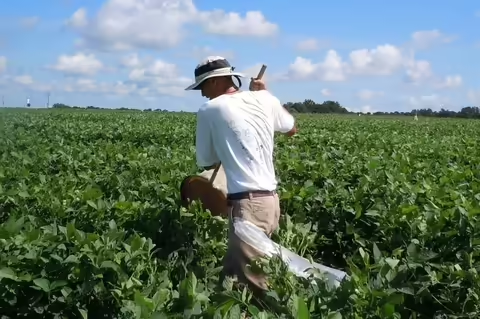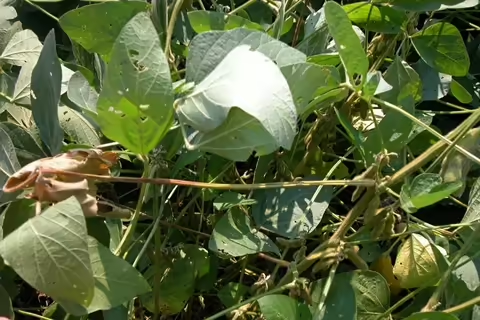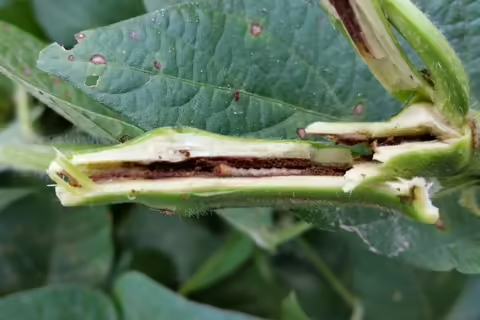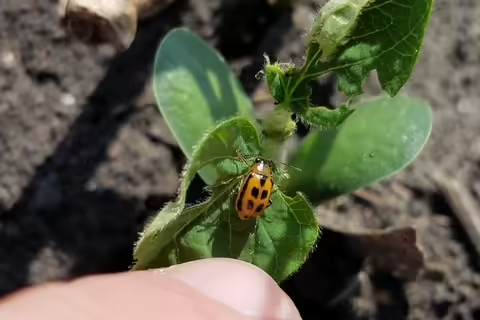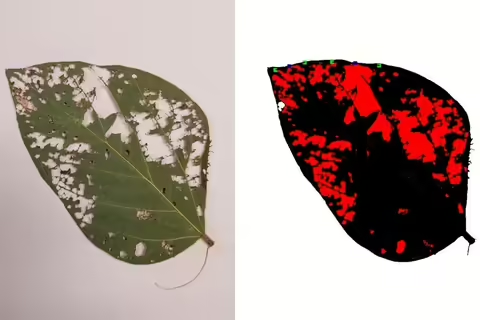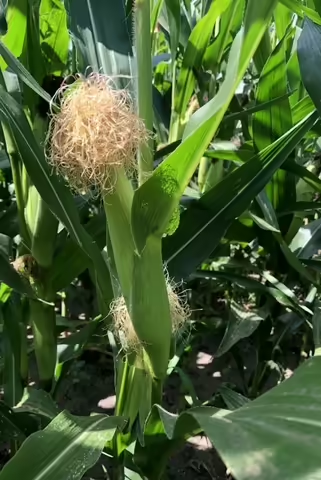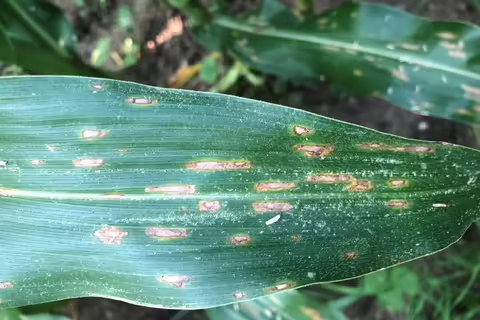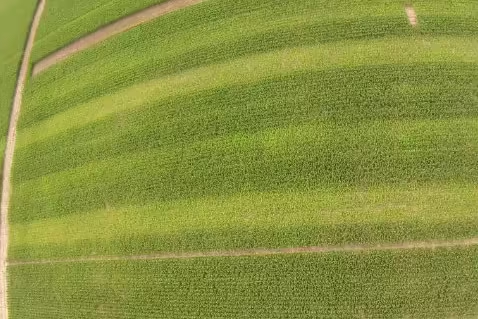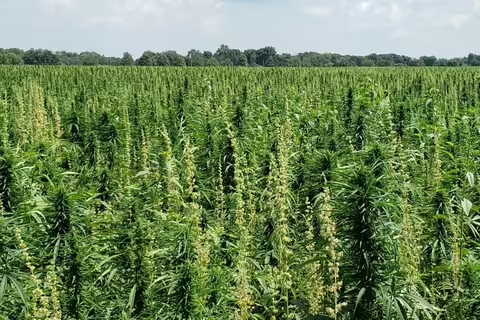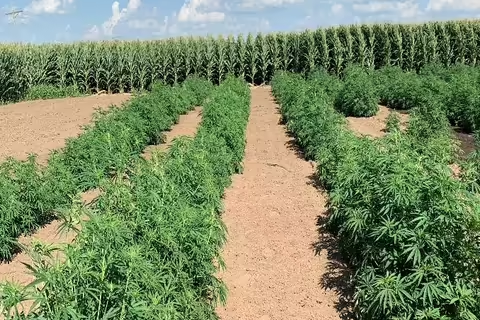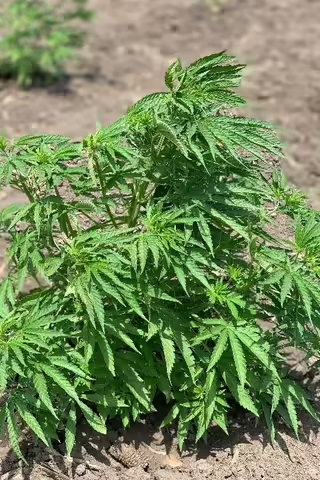Insect monitoring in soybeans: What to look for during pod fill
By Dr. Nicholas Seiter, Assistant Professor, Extension Entomologist
At this point in the season, most of our insect monitoring efforts are focused on soybean. There are several pests that can damage soybean during pod fill, and proper scouting is necessary to identify and control these insects. While not an exhaustive list, these are some of the insects and insect relatives to be on the lookout for as the growing season winds down.
Stink bugs. Stink bug (Fig. 1) feeding during pod fill (particularly R5-early R6) can reduce soybean yield and quality. These insects feed directly on the developing seeds, resulting in wrinkling, shriveling, and discoloration in addition to reductions in yield. This damage can be compounded by pathogens and weather; note also that pathogen and weather-related quality issues can sometimes be confused for stink bug damage. Unfortunately, many fields in Illinois are not thoroughly scouted for insects during pod fill, and infestations sometimes go unnoticed until the crop is graded at the elevator.
When scouting fields for stink bugs, simply walking the field is not sufficient to assess the extent of the stink bug population. The most effective way to scout for these insects is with a sweep net (my personal favorite) or a drop cloth. Both methods are also effective for many other soybean pests. A sweep net (Fig. 2) is swung through the canopy perpendicular to the rows a set number of times, often 25 “sweeps” per sample. With a drop cloth, a small section of a row, usually 3 feet, is shaken vigorously over a cloth, and the insects that are dislodged from the soybean canopy are counted. An insecticide application is warranted if you meet or exceed the economic threshold, which is 9 per 25 sweeps with a sweep net or 1 per row foot using a drop cloth. Note that the window of residual activity provided by insecticides for stink bug control is short, generally less than 1 week); therefore, preventative applications targeted to a certain growth stage are unlikely to be effective. The most effective applications are those that are made only when a damaging population occurs – still a rare event in most of Illinois.
Spider mites. Unfortunately, we have struggled with drought stress in much of Illinois in recent weeks. While not a problem every year (and not an insect), spider mites often become an issue when soybeans are drought stressed. Spider mite feeding causes yellow to brown discoloration of soybean foliage and can result in severe stress to the plant. The infestations often begin at field edges. Closely examining infested foliage will reveal the mites and the webbing that they produce. Shaking the mites onto a white piece of paper or using a hand lens might be necessary, as they are quite small.
Dectes stem borer. This insect caused some unexpected damage in southern Illinois in 2018. The stem borer larva feeds on the pith inside the soybean stem. As the plant matures, the larvae can girdle stems which leads to lodging, especially in situations where harvest is delayed. While we do not have an economic threshold for this insect or a reliable way to control the larvae with insecticides, infested fields can be identified and, where possible, prioritized for earlier harvest to reduce their potential for lodging. Adult dectes stem borers are gray, long horned beetles that can be found using a sweep net or drop cloth. The first sign of infestation by the larvae is usually “flagging” of petioles in which a dectes larva has been feeding (Fig. 3). The larvae themselves can be observed by slicing the stem in half (Fig. 4).
Bean leaf beetle. Bean leaf beetle adults (Fig. 5) tend to be both the first and the last defoliating pest to enter soybean fields. As with other defoliating insects, the decision of whether to treat should be made based on (1) the level of defoliation in the field (the economic threshold post-bloom in Illinois is 20% defoliation) and (2) the continued presence of the pest within the field. Estimate the overall percent defoliation by collecting individual leaflets throughout the field. There are now several smartphone apps available that can help you to calibrate your defoliation estimation skills. One app to consider is BioLeaf Foliar Analysis for Android. (Fig. 6).
Resistance for Fusarium head blight is key in integrated disease management strategy for wheat in 2020
By Dr. Nathan Kleczewski, Research Assistant Professor and Extension Pathologist
It seems hard to believe, but soon we will be planting our winter wheat for the 2020 growing season. Diseases were not a major issue in Illinois this season and only some pockets of fields in parts of the state suffered from Fusarium head blight (FHB) at levels that resulted in vomitoxin (DON) contamination and reduced yields.
Successful management of FHB must include an integrated approach. No single management strategy will be effective at reducing yield loss and vomitoxin contamination in a disease-favorable environment. We cannot completely stop damage from FHB, but we can suppress its effects and reduce yield damage. The first and most important tool growers have in their tool box is the use of a variety with moderate resistance to FHB. Varieties with moderate resistance to FHB will have reduced yield losses compared to susceptible varieties and will help reduce vomitoxin contamination in the grain. As we are all aware, if the vomitoxin content in the grain exceeds the maximum acceptable levels, the grain will be docked or deemed not be acceptable for sale. My goal as an extension plant pathologist is to help producers effectively manage FHB so that the vomitoxin levels in their grain is below the acceptable thresholds allowing for the sale of their grain.
Vomitoxin advisory levels for wheat in the United States
| Animal | Maximum Acceptable DON Level |
|---|---|
| Swine | 5 ppm: Not to exceed 20 percent of ration with finished feed |
| Beef and feedlot cattle more than 4 months old | 10 ppm: Not to exceed 50 percent of diet with finished feed |
| Poultry | 10 ppm: Not to exceed 50 percent of diet with finished feed |
| Other animals | 5 ppm: Not to exceed 40% of diet |
| Human consumption = 1ppm |
In research conducted from 2007-2010, the use of moderately resistant varieties reduced severity of visual symptoms of FHB on wheat heads and grain by over 50% compared to susceptible checks (yellow bars in Figure 1a and 1b). Additionally, when using an FHB fungicide such as Prosaro or Caramba, the use of a MR variety reduced FHB and DON by over 70%.
Let’s put that in perspective. Grower A plants a susceptible variety and doesn’t spray for FHB, and grower B plants a MR variety and sprays with Caramba or Prosaro at FGS 10.5.1. Both varieties are stripped 3x into the same field. If average DON for grower A comes back at 10 ppm, then we would expect the average DON for grower B to come in around 3 ppm. Grower A will likely need to dispose of his/her grain, but grower B can sell his as feed quality grain.
Scouting corn for fungicide applications – It’s not fun, but it’s not hard
Russ Higgins, Extension Educator, Commercial Agriculture, Northeast Illinois
For many farmers the judgement on whether to use a fungicide, or not, is made well before the crop is planted. Fungicide usage decisions made when pricing inputs is counter to integrated pest management (IPM) principles. A key to IPM is scouting the crop and basing treatment decisions on economic thresholds. Our initial decision on disease management begins with hybrid selection and awareness of the disease tolerance/resistance inherent in that variety. After the corn is in the ground, when do we scout? Our recommendation is visiting fields at least once a week, more if issues arise. We have some disease wild cards, like Southern rust and Tar spot, which if established may benefit from earlier fungicide applications.
For most fungal leaf diseases including Gray leaf spot and Northern corn leaf blight, we normally get the greatest return on investment from a tasseling/silking (VT/R1) fungicide application. University of Illinois Plant Pathologist Dr. Nathan Kleczewski shares that fungicides DO NOT INCREASE YIELD POTENTIAL. They do not increase yield. They protect potential yield by mitigating losses due to fungal disease. As your corn crop nears tasseling (VT), be observant of the diseases present, disease pressure, and disease location on the crop canopy. Our greatest concern is the ear leaf and those above. They are responsible for 75 to 90% of the carbohydrates assimilated in the kernels. This information, along with knowledge of the variety’s disease susceptibility will aid in the decision of the economic benefit of a fungicide application. To determine expected bushels needed to justify a treatment, Application cost ($/A) / expected crop price ($/bu) = Yield protected (bu/A). Using current numbers as an example. A fungicide application made at R1 aerially has a cost of approximately $27.00 (fungicide plus application cost). $27/ $4.30 (expected corn price) = 6.3 bushel. If your realistic expectation is a gain a 6 bushel or more, a fungicide is justified. If not, the prudent decision would be to not apply a fungicide. So, don’t make fungicide applications decisions from your office chair, get into the corn fields (a broad brimmed hat looks funny, but stops a lot of pollen from gathering around your neckline) and scout your corn field’s upper canopy to make an informed decision.
For more crop disease info, visit the Illinois Field Crop Disease Hub.
Southern Illinois crop report
Talon Becker, Extension Educator, Commercial Agriculture, Southern Illinois
After the excessive precipitation we endured in the southern Illinois region and much of the state this planting season, dryer weather appears to have returned to most areas. According to the Midwest Regional Climate Center, although the region is still anywhere from 9-15 inches above average for precipitation in the calendar year, a good portion of the southern Illinois region has received below average precipitation over the past 30 days (July 7 - Aug. 5). These dryer areas tend to be in the northern and northeastern parts of the region, with deficits ranging from 1-2 inches below normal for this period. However, this is not the story for many of the counties in the St. Louis Metro East area and the southern tip of the state. These areas have continued to receive some heavier rain events over the past month, keeping them above average over that period and continuing the wet trend in that region.
In the areas where dryer weather has set in over the past month, some water stress is starting to become apparent. With many of the rain events we have received lately being highly scattered and variable in accumulation, the appearance of rolled corn leaves tends to be equally spotty. Much of the region has received small occasional showers that has helped to limp many fields along, but with the late pollination period this season due to the delayed planting, many are concerned how this stress will affect their yields.
Many corn fields continue to show uneven growth and tassel emergence because of the uneven emergence and early growth in saturated soils this spring and early summer. With tassel shed and silk emergence just starting to pick up over the last week or so in much of the region, it is still too early to tell what final yields will be. The threat of late onset diseases could also negatively affect yields, but for the most part, disease pressure has been low, perhaps aided by the dryer weather. Southern rust has been confirmed in several counties in southeastern and south central Illinois, but disease incidence in these fields was still reported to be low.
Many full season soybean fields I have walked through have started flowering or are close to full bloom, but canopy closure continues to be an issue this year. While driving around the region, it is rare to see a soybean field with a full, even canopy where it is difficult to discern rows. In many cases, bare soil is still visible between the rows. This lack of canopy, delayed post-emergence sprays due to a tropical storm, and excessive heat when many post-emergence sprays were applied has led to poor weed control in many bean fields. Double crop soybeans are generally somewhere in the V2-V5 range, but this, again, varies quite a bit around the region depending on variable rain accumulations which may or may not have delayed wheat harvests and double crop planting as well as early crop growth.
At the Ewing Demonstration Center, in addition to the research plots with traditional crops like corn and soybeans, we have one location of a multi-location industrial hemp variety trial looking at seed and fiber production potential. While not part of the experimental design, various management techniques are being utilized at the different locations, depending on available equipment and historical production systems at those locations. The Ewing Demonstration Center is historically a no-till farm with many of the earliest no-till trials being conducted there. In this spirit, we decided to attempt to grow industrial hemp this year in a no-till production system. The plot space which was available for this trial was split the previous year between soybeans and popcorn. The popcorn side of the plot had poor late season weed control while the soybean side was virtually weed-free at harvest. The plan at the beginning of the season was to plant the hemp June 1 with a grain drill on 8" rows. We hoped the tight rows would lead to early canopy closure before many of the troublesome summer weeds emerged. However, with an initial planting date of June 14 and a forced replant on July 2 after a large rain event at a vulnerable growth stage, we no longer had our head start. Even though the plot had an effective burndown the morning before replanting, the next flush of weeds has grown right along with the hemp. With no residual or in-season herbicides currently labelled for hemp, weed control will be a definite challenge for producers, especially in late planting situations. Other locations have utilized cover crops for weed suppression, and this may be our only option for weed control in no-till industrial hemp until we have chemical weed control options. Beyond trials investigating the compatibility of this crop with different cover cropping systems, other agronomic trials, such as tillage, seed rate, fertility, and fungicide trials are needed to optimize production methods for this crop in each particular region, but are greatly dependent on our ability to secure funding for this work.
University of Illinois partners with Highland Community College Agriculture
Phillip Alberti, Extension Educator, Commercial Agriculture, Northern Illinois
A late harvest in 2018 made things difficult up here in the northwest corner; field operations were delayed significantly or postponed all together. Then, a historically spring really pushed things back for our producers. Many questions were asked, and decisions had to be made. Do I switch maturity groups? Do I switch to soybeans? Should I just plant a cover crop? The reality is that “prevented plant” put producers in some tricky spots, and so they did their best to make the most out of this unpleasant situation. Some did so by planting beneficial cover or forage crops. Typically, conditions in Northern Illinois are not suited to cover crop use as shortened growing seasons and harsh winters make proper establishment difficult, but this year provided a unique opportunity to get them to work. Whether cover crops were used to gain additional forage, an attempt to boost productivity of the next cash crop, or just trying something new, there are a lot of creative things going being done up here. The good news is that is still not too late to give cover crops a try in 2019 and with the many cover crops out there, there is likely something out there which may fit into your production system. For more research, reach out to your local extension agent!
University of Illinois Extension in partnership with Highland Community College Agriculture will be hosting their 2nd annual Crop Research Field Day on Wednesday, September 4, 2019 in Freeport, IL. The public is invited to attend to learn about the research taking place at Highland Community College’s research plot as well as hear from Extension specialist throughout the state regarding 2019 crop production issues. Topics of research this year include: tar spot fungicide trials, corn nitrogen rate trials (Fig 1), corn population trials, a cover crop species demonstration and industrial hemp (Fig 2-4). This industrial hemp demonstration is part of a multi-location study assessing various production practices across the state; this demonstration is not replicated but is being used as a baseline for future research and public education. The college intends to share the progress of this research at this event and plans to report the final data to the public at the conclusion of the growing season. For more information, check out our collection of research and resources about industrial hemp.
The research plot is in its second year of production at Highland Community College through generous donations from local sponsors. The 15-acre plot serves as a land lab where students gain hands on experience with crop production and research design. University of Illinois Extension educator Phillip Alberti will discuss northwest Illinois production concerns from throughout the growing season as well as his experiences growing industrial hemp for grain, fiber, and CBD. Crop science educator Russ Higgins will discuss weed issues and control methods in corn. Nathan Kleczewski is an extension specialist at the University of Illinois and will be speaking about corn diseases and control options.
The field day, located at Highland Agriculture’s research plot located at 3472 W. Loras Drive in Freeport, IL, is a free event and will begin at 9 a.m. and conclude 11 a.m. A light breakfast is included; however, participants are asked to register by Friday, August 30th. Those interested in attending may register online or by calling the University of Illinois Extension-Stephenson County at 815-235-4125. For additional questions, contact Phillip Alberti, Crop Science Educator with University of Illinois Extension in the College of Agricultural, Consumer, and Environmental Sciences at palberti@illinois.edu, 815-599-3644 or on Twitter (@NorthernILCrops).
Recent Updates from the Bulletin
For more important information, see the following updates from University of Illinois Extension Specialists and Educators.
Let us know if you see these diseases in Illinois! (Posted on August 8, 2019 by Nathan Kleczewski)
2019 Observations from the Field: Dicamba (Posted on August 2, 2019 by Aaron Hager)
Corn and soybean crops at mid-season, 2019 (Posted on July 19, 2019 by Emerson Nafziger)
Southern rust in Illinois- it’s complicated (Posted on July 18, 2019 by Nathan Kleczewski)
